You’re about to discover how to completely transform your living spaces using strategic plant placement and creative display methods. From statement-making living walls that span 8 feet high to compact herb gardens that fit in a 2×3 foot kitchen corner, these eight design approaches will help you maximize both vertical and horizontal areas. Whether you have a sprawling home or a cozy apartment, you’ll find practical ways to incorporate greenery that matches your style and space constraints.
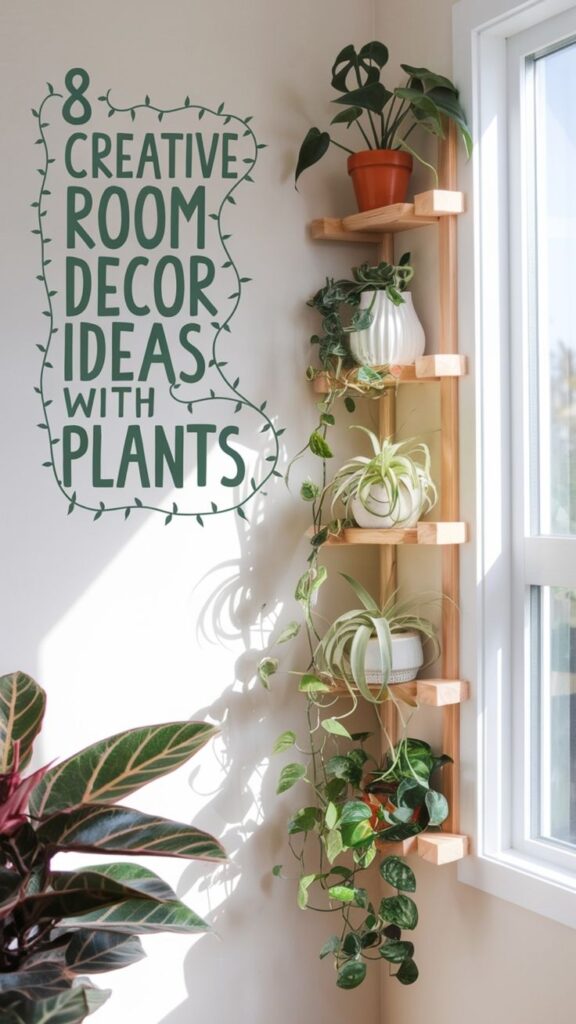
Contents
Living Plant Walls for Statement Impact
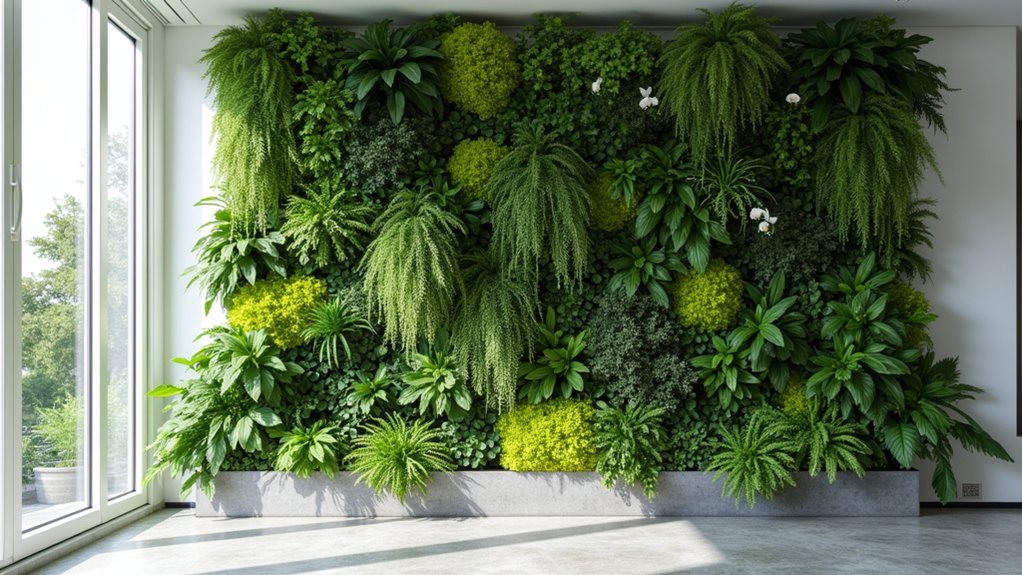
Living plant walls transform vertical spaces into lush, verdant tapestries of foliage, creating dramatic visual impact in any room. These architectural features combine multiple plant varieties in a modular or custom-designed framework, often incorporating both trailing and upright specimens to achieve depth and texture.
Plant walls can range from small framed installations to floor-to-ceiling living murals, with plants growing in specialized pockets or panels filled with growing medium.
- Light Requirements: Bright, indirect light; avoid direct sunlight which can scorch leaves; artificial grow lights can supplement in low-light areas
- Water Needs: Regular moisture through built-in irrigation systems or manual watering; soil should remain consistently moist but not waterlogged
- Growing Medium: Lightweight, well-draining soil mix specifically designed for vertical gardens
- Temperature Range: 65-80°F (18-27°C)
- Humidity: Minimum 40%, preferably higher
- Air Circulation: Good airflow to prevent mold and fungal issues
Regular maintenance is essential for a thriving plant wall. Weekly inspections help identify and address any failing plants or irrigation issues promptly.
Pruning dead or yellowing foliage, monitoring for pests, and cleaning the leaves to remove dust will keep the wall looking pristine.
Fertilizing every 4-6 weeks during growing season with a balanced, water-soluble fertilizer ensures proper nutrition, while quarterly assessment of the support structure and irrigation system prevents potential structural problems.
Floating Shelves With Cascading Greenery
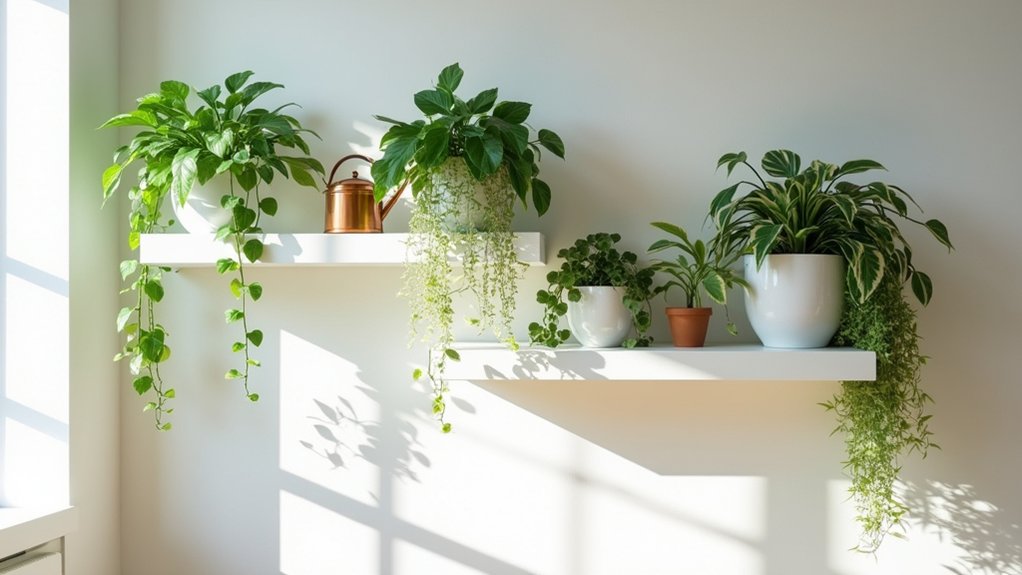
Floating shelves adorned with cascading greenery create a stunning vertical garden effect that draws the eye upward while maximizing space. These wall-mounted displays typically feature trailing plants like pothos, string of pearls, or ivy that gracefully spill over the edges, creating a waterfall-like appearance.
The shelves themselves can be arranged in various patterns – staggered, aligned, or grouped – to achieve different aesthetic effects while providing multiple levels for plant placement.
Growing Conditions:
- Bright, indirect light is ideal for most trailing plants, though some varieties can tolerate lower light
- Well-draining potting mix with adequate aeration
- Temperature range of 65-80°F (18-27°C)
- Moderate humidity levels (40-60%)
- Water when top 1-2 inches of soil feels dry
- Choose shelves rated for the weight of pots, soil, and mature plants
Regular pruning and rotation are essential for maintaining an attractive cascading display. Trim leggy growth to encourage fuller, bushier plants, and rotate pots quarterly to ensure even growth on all sides.
Clean shelf surfaces monthly to prevent water damage and mold growth, and inspect plant ties or supports regularly to ensure trailing stems are secure but not constricted.
Vintage Ladder Plant Display
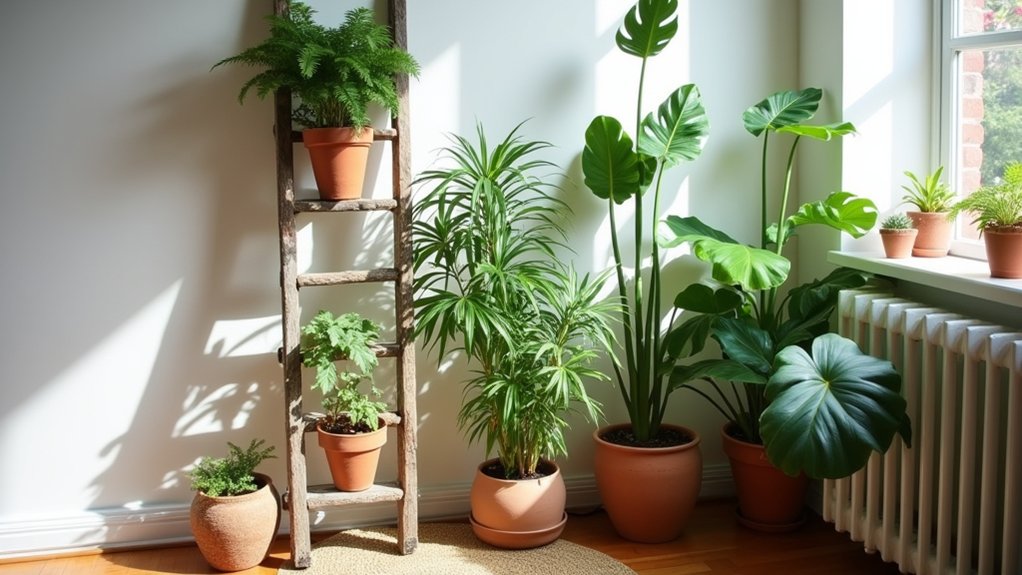
A vintage ladder plant display transforms an old wooden ladder into a charming, multi-tiered plant stand that adds rustic character to any room. The ladder’s steps serve as natural shelving for potted plants, creating a vertical garden that maximizes space while making a striking visual statement.
Whether leaning against a wall or standing independently in a corner, this display method allows for creative arrangement of various plant sizes and trailing varieties, with smaller pots on upper rungs and larger specimens toward the bottom for stability.
Growing Conditions:
- Position ladder near windows for optimal natural light, ideally within 3-6 feet of light source
- Ensure ladder is stable and level to prevent pots from tipping
- Choose pots with drainage holes and matching saucers to protect ladder rungs
- Arrange plants based on individual light requirements – sun-loving plants on higher rungs
- Space plants to allow adequate air circulation between specimens
To maintain a thriving vintage ladder plant display, rotate pots quarterly to ensure even growth and prevent plants from growing toward light sources.
Regularly inspect the ladder for any water damage or wear, and apply wood sealant as needed to protect against moisture. Remove any fallen leaves or debris that collect on rungs to prevent rot and pest issues.
When watering, take care not to oversaturate the wood by removing plants to water elsewhere or using careful spot watering techniques.
Hanging Macramé Garden Sanctuary
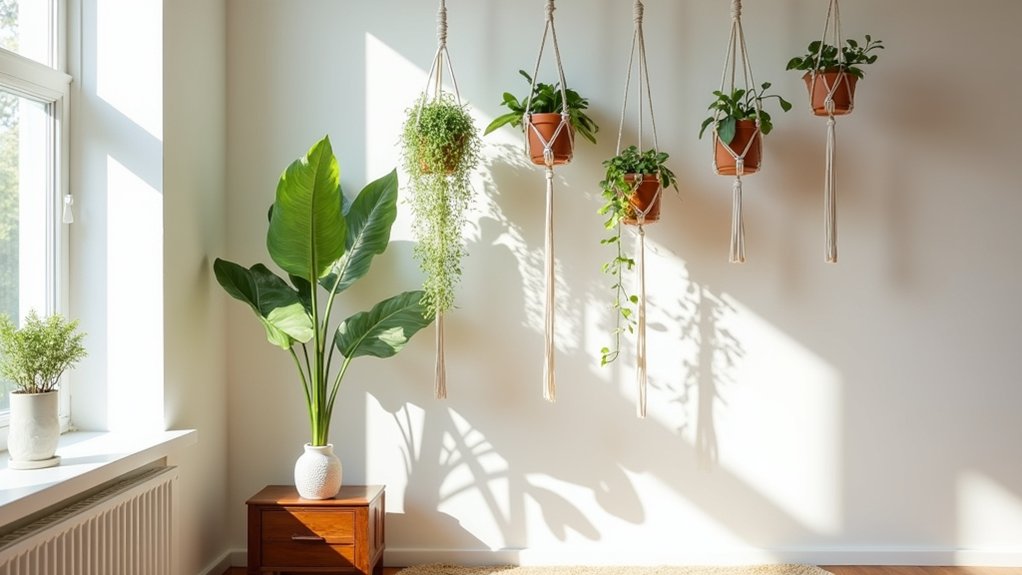
A hanging macramé garden sanctuary transforms indoor spaces into lush, vertical gardens using handcrafted rope holders suspended from ceilings or wall brackets.
These decorative plant displays typically feature an array of trailing plants cascading from multiple levels of intricately knotted natural fiber hangers, creating a bohemian aesthetic while maximizing vertical space.
The woven patterns of macramé combined with varied plant textures and lengths create visual interest and depth, making them perfect focal points for living rooms, bedrooms, or covered patios.
Growing Conditions:
- Bright, indirect light for most hanging plants
- Avoid direct afternoon sun which can damage delicate foliage
- Moderate temperatures between 65-80°F (18-27°C)
- Humidity levels around 50-60%
- Well-draining potting mix suitable for indoor plants
- Containers must have drainage holes
- Space between plants to allow proper air circulation
Regular maintenance ensures the longevity of both the macramé hangers and plants.
Dust macramé cords monthly with a soft brush to prevent dirt buildup, and check knots periodically for stability.
Rotate plants quarterly to ensure even growth, and trim yellowing or dead foliage promptly to maintain aesthetic appeal.
When watering, remove plants from hangers if possible to prevent water damage to the macramé, allowing them to drain completely before replacing.
Inspect plant stems where they contact the macramé to prevent potential damage from friction.
Window Seat Botanical Nook
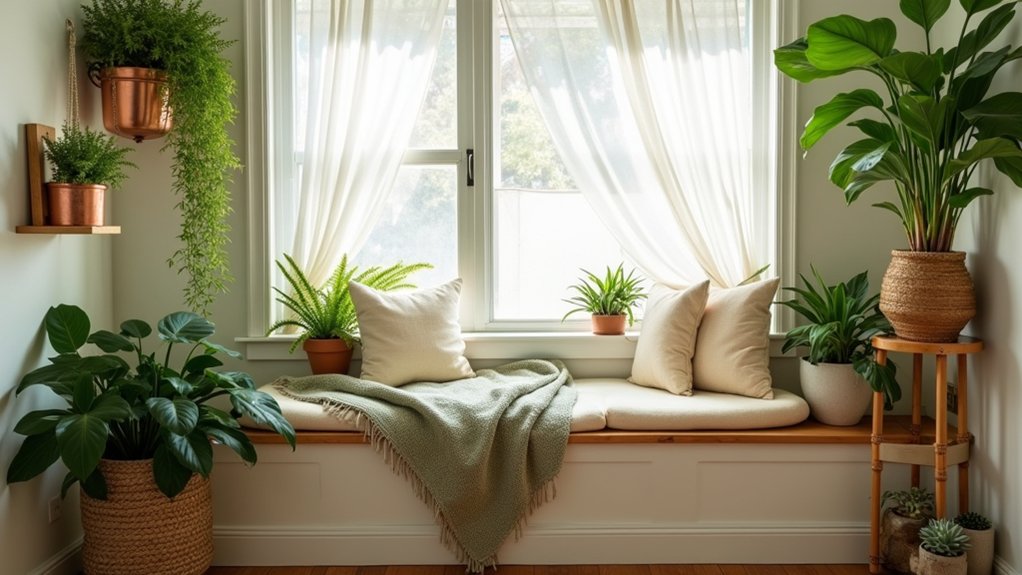
A window seat botanical nook transforms an ordinary window alcove into a lush, green retreat perfect for reading or relaxation. This cozy space typically features comfortable cushions surrounded by an assortment of plants arranged on floating shelves, windowsills, or hanging planters.
The plants can include trailing varieties like pothos or ivy cascading down the sides, compact plants like ferns or peace lilies at eye level, and small succulents arranged on decorative stands, creating a layered garden effect that frames the natural light streaming through the window.
Growing Conditions:
- Bright, indirect light from the window, ideally east or north-facing to prevent leaf burn
- Room temperature between 65-80°F (18-27°C)
- Moderate humidity levels, enhanced by grouping plants together
- Well-draining potting mix appropriate for each plant variety
- Regular rotation of plants to ensure even growth and prevent leaning
- Space between plants for adequate air circulation
Maintaining a thriving window seat botanical nook requires regular dusting of leaves to maximize light absorption and photosynthesis.
Establish a consistent inspection routine to catch any pest issues early, and trim yellowing or dead foliage promptly to maintain aesthetics and plant health.
Group plants with similar water needs together for efficient care, and consider installing sheer curtains to filter intense afternoon sun if necessary.
During winter months, move sensitive plants a few inches away from cold window glass to protect them from temperature fluctuations.
Geometric Terrarium Centerpieces
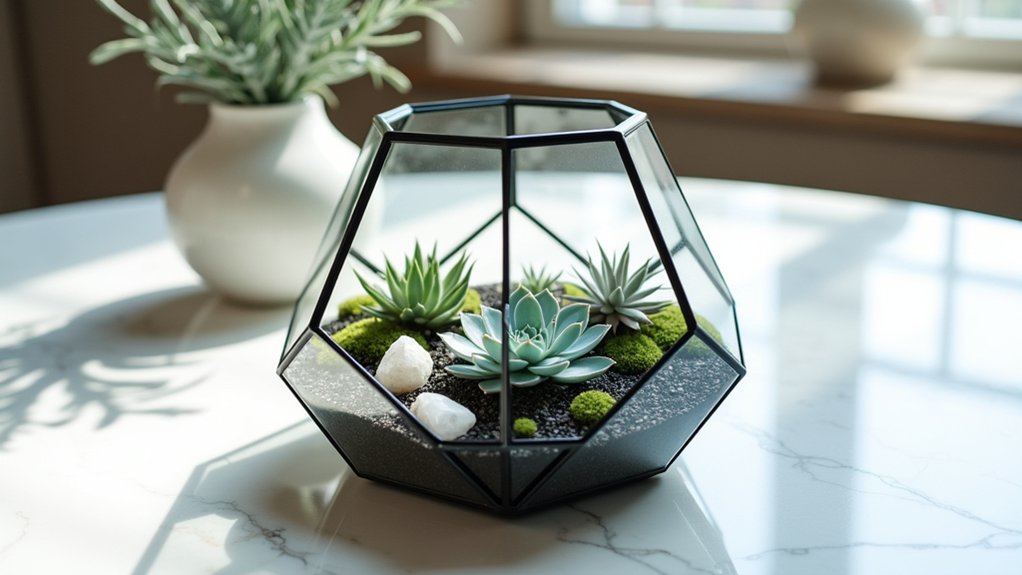
Geometric terrariums serve as striking centerpieces that combine modern design with natural elements. These angular glass containers, typically featuring clean lines and metallic or black frames, house carefully arranged miniature landscapes of succulents, air plants, or small tropical specimens.
The transparent geometric shapes create a contemporary architectural element while allowing full visibility of the enclosed plant composition, making them ideal focal points for dining tables, coffee tables, or office desks.
- Light: Bright, indirect sunlight; avoid direct afternoon sun that can overheat the enclosed space
- Water: Light misting every 7-10 days for closed terrariums; weekly watering for open designs
- Soil: Well-draining succulent mix for desert plants; sterile potting mix with added perlite for tropical varieties
- Temperature: 65-80°F (18-27°C), protect from cold drafts
- Humidity: Self-regulating in closed terrariums; 40-60% for open designs
- Container: Must have drainage holes or adequate drainage layer for open designs
Regular maintenance ensures the longevity of geometric terrarium centerpieces. Trim dead or yellowing foliage promptly to prevent decay, rotate the container quarterly for even growth, and clean the glass surfaces monthly using a soft, lint-free cloth.
Remove any signs of mold immediately and adjust ventilation as needed. When plants outgrow their space, prune them back or transplant to maintain the desired aesthetic and prevent overcrowding.
Kitchen Herb Garden Gallery
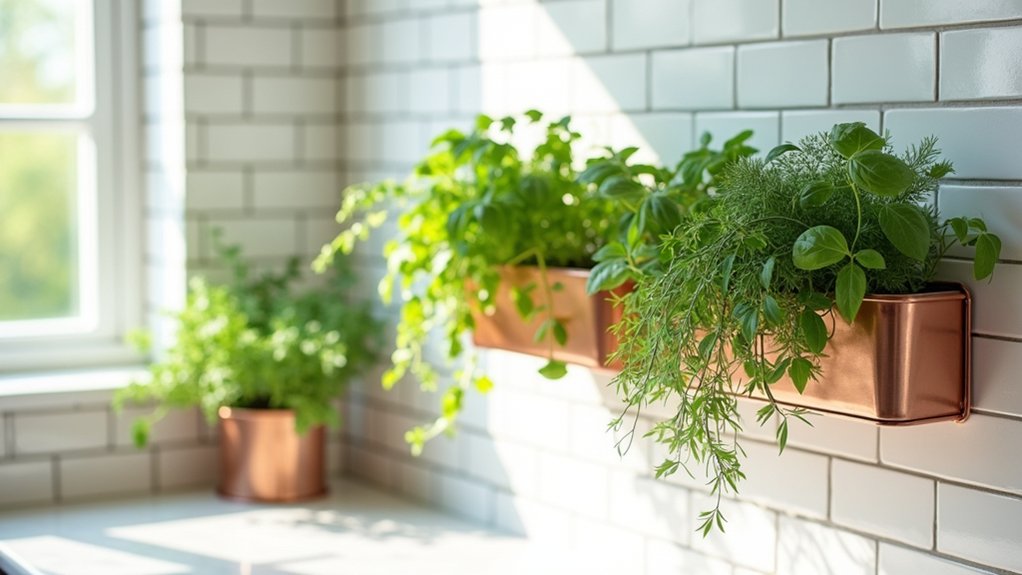
A kitchen herb garden gallery transforms an ordinary kitchen into a living, aromatic workspace by displaying various culinary herbs in an organized, accessible arrangement. Typically mounted on walls, placed on windowsills, or arranged on countertops, these gardens feature a collection of essential cooking herbs like basil, thyme, rosemary, and mint in coordinated containers.
The display can include tiered stands, hanging planters, or vertical garden systems, often incorporating complementary design elements such as matching pots, labels, or decorative trellises.
- Light Requirements: 6-8 hours of direct sunlight daily; south or west-facing windows ideal
- Water Needs: Moderate moisture; soil should be kept consistently damp but not waterlogged
- Soil Type: Well-draining potting mix with good aeration
- Temperature: 65-70°F (18-21°C) for optimal growth
- Container Requirements: Pots with drainage holes, minimum 6 inches deep
- Spacing: 4-6 inches between plants for proper air circulation
- Humidity: 40-50% relative humidity
Regular pruning and harvesting are essential for maintaining a thriving kitchen herb garden gallery. Trim herbs frequently to encourage bushier growth and prevent flowering, which can make the leaves bitter.
Rotate containers periodically to ensure even growth, and maintain good air circulation between plants to prevent fungal issues. Remove any yellowing or dead leaves promptly, and fertilize with a balanced, water-soluble fertilizer every 4-6 weeks during the growing season.
Bathroom Tropical Oasis Design
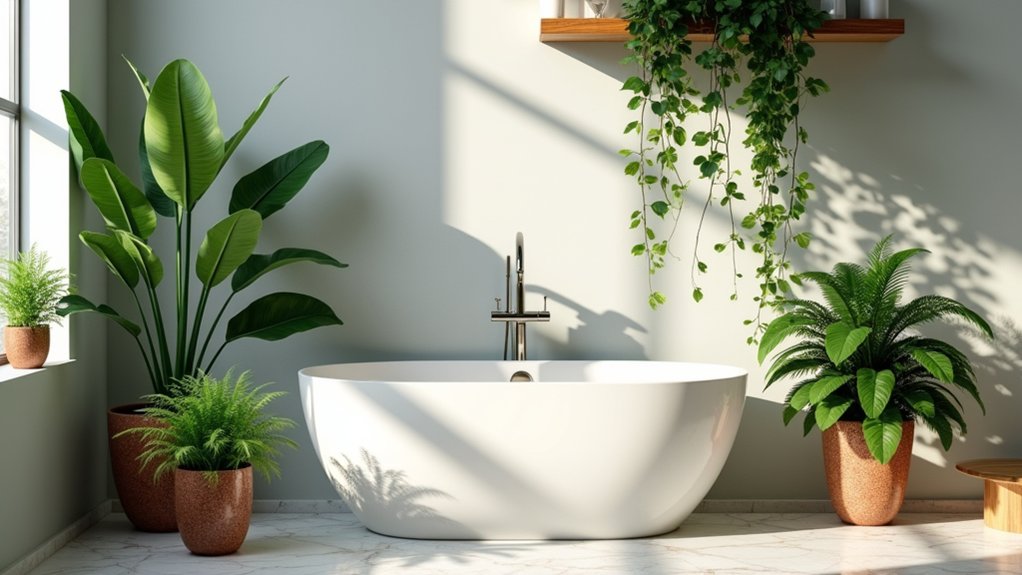
Transform your bathroom into a luxurious tropical retreat by incorporating lush, humidity-loving plants that thrive in the naturally steamy environment. Large-leafed specimens like bird of paradise, monstera, and peace lilies create dramatic focal points, while hanging pothos and ferns cascade from shelves or shower rods.
The combination of glossy foliage, varying heights, and natural textures against white bathroom fixtures creates a spa-like atmosphere that brings the outdoors in.
Growing Conditions:
- Bright indirect light or artificial grow lights, as bathrooms often lack natural light
- High humidity levels (50-80%) from shower steam
- Well-draining potting mix with added perlite
- Temperatures between 65-80°F (18-27°C)
- Protection from cold drafts from windows or vents
- Container with drainage holes to prevent root rot
Regular pruning of yellowing leaves, monthly dusting of foliage, and rotation of pots every few weeks ensures even growth and maintains the aesthetic appeal of your bathroom jungle.
Group plants with similar water needs together for easier care, and consider installing a small fan for air circulation to prevent mold growth.
Monitor plant roots periodically for signs of outgrowing their containers, and maintain cleanliness by promptly removing fallen leaves or plant debris from surfaces.
